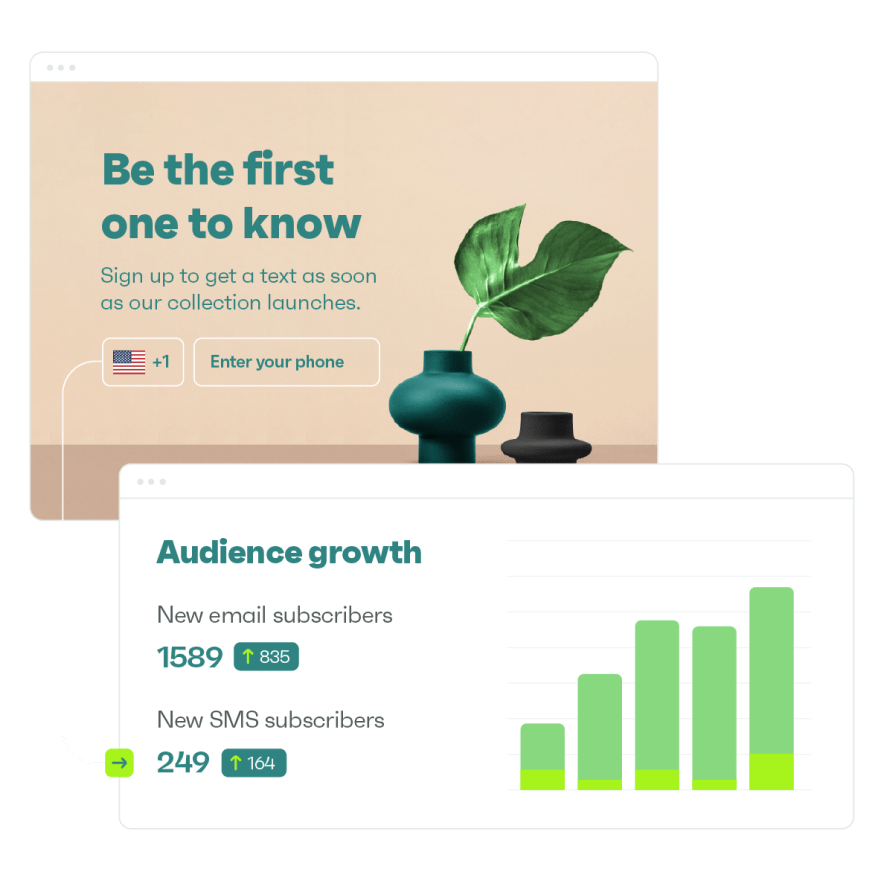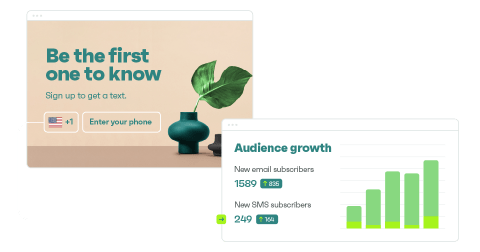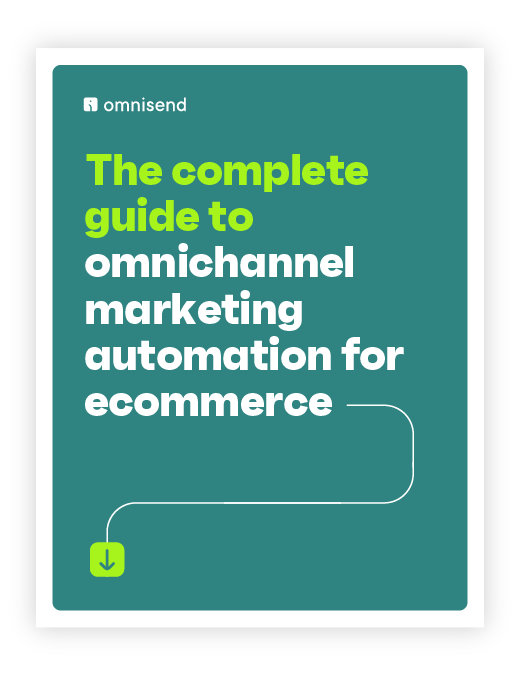Drive sales on autopilot with ecommerce-focused features
See FeaturesCustomer lifecycle marketing: strategy, benefits, examples [2024]
Customer lifecycle marketing uses highly targeted campaigns and initiatives tailored to each stage of the customer journey. It’s a strategic approach for creating personalized, relevant messaging and experiences for customers throughout the marketing and sales funnels.
It’s often less expensive to retain customers than to acquire new ones. This makes customer lifecycle marketing extremely effective for retaining this lifetime value, building stronger customer relationships, increasing loyalty, and reducing churn.
By focusing on the whole customer journey, you can better identify pain points and address problem areas to improve the customer experience. With this approach, you ensure the best chance of conversion every time a customer interacts with your brand.
In this post:
- What is customer lifecycle marketing?
- Benefits of customer lifecycle marketing
- Customer lifecycle marketing stages
- Customer lifecycle marketing examples
- Customer lifecycle marketing strategies for every stage
What is customer lifecycle marketing?
Effective customer lifecycle marketing uses multiple marketing channels to target the unique challenges and opportunities that arise at each stage of the customer journey. With this type of marketing, you need to develop tailored marketing initiatives that align with customers’ needs and goals.
Data-driven insights and customer segmentation are hallmarks of customer lifecycle marketing. By leveraging this information, you can better optimize complimentary marketing approaches, improve customer engagement and loyalty, and increase the potential for conversion.
Benefits of customer lifecycle marketing
Here are some of the benefits of customer lifecycle marketing:
- Aligned marketing and customer experience: It helps create a cohesive brand experience for customers, staying consistent across all touchpoints
- Better brand visibility: It creates a consistent experience for customers, reinforcing your brand message and values, which can greatly improve visibility
- Greater value at every customer journey stage: It tailors messaging and experiences at each stage, providing more value no matter where customers are in their journey
- Increased customer retention and loyalty: It focuses on building strong customer relationships throughout the marketing and sales lifecycle, boosting loyalty and customer retention
- Higher customer lifetime value (CLV): It can boost CLV through greater customer retention, repeat business, and upselling and cross-selling opportunities
Customer lifecycle marketing stages
The customer lifecycle may be long or short, depending on the industry and the products/services a business offers. Grocery chains, such as Walmart, tend to have a shorter cycle, while companies like Mercedes have longer ones.
Regardless of the length, the customer lifecycle can be divided into various stages.
According to marketing analysts Jim Sterne and Matt Cutler, the customer lifecycle can be divided into five stages.
Let’s look at a brief breakdown of each of the five stages of the customer lifecycle:
- Reach: This is the initial stage when you aim to build brand awareness, reach new potential customers, and increase traffic to your website
- Acquisition: The customer gets in touch with you at this stage. You offer them products or services that suit their needs and explain the benefits of your products or services
- Conversion: At this stage, the customer makes a purchase, after gaining all the necessary information from the previous stage
- Retention: This involves ongoing efforts to keep existing customers engaged and satisfied with your products or services
- Loyalty: This is the stage where a customer becomes a repeat buyer and brand advocate due to their positive experiences
Understanding the different stages of the customer lifecycle will give you a solid basis for creating tailored strategies to attract, engage, retain, and build better customer loyalty. As Jim Sterne says, it’s important to focus your company’s efforts on the goals of these stages.
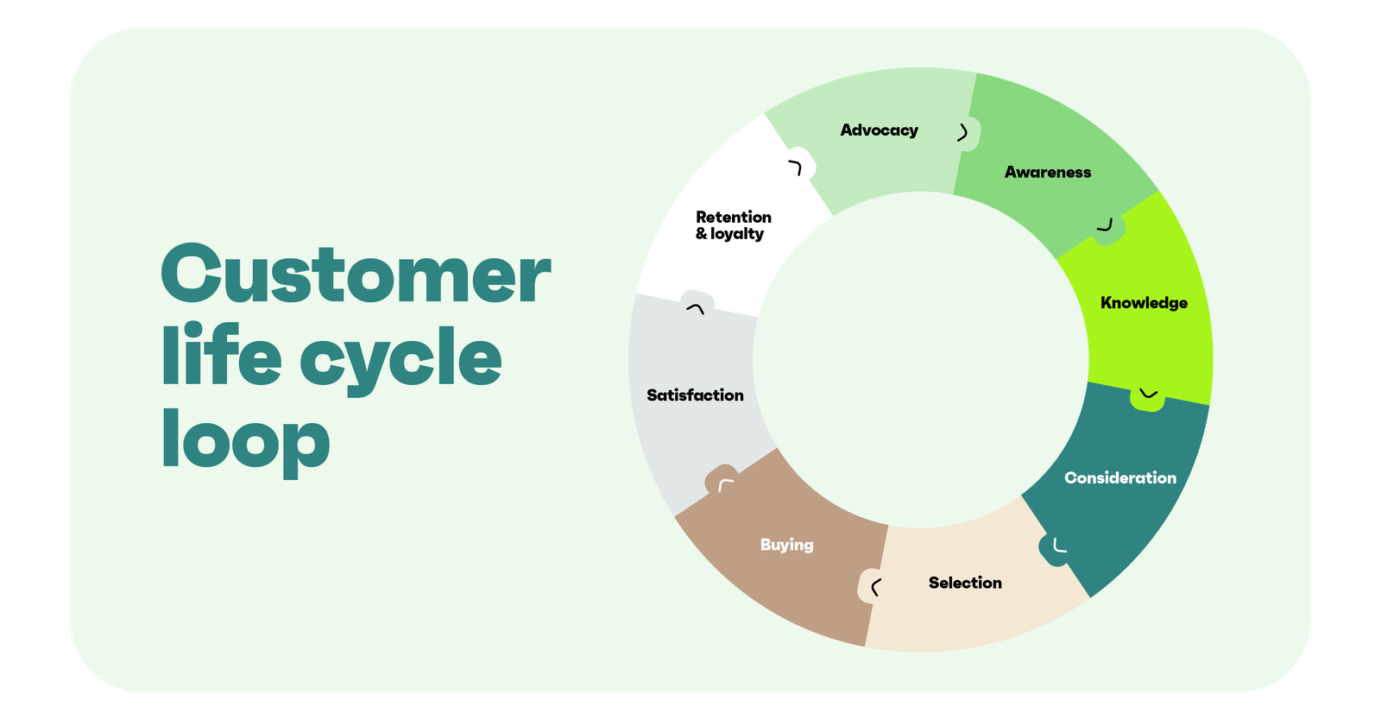
“Company functions should be assigned based on these stages rather than on specific technologies.”
Jim Sterne, marketing analyst
Customer lifecycle marketing examples
Generating sales and getting repeat business means delivering consistent value across each stage of the customer lifecycle. Some brands do it better than others.
For deeper insight into developing your initiatives, consider the following examples of customer lifecycle marketing for different stages of the customer journey:
1. Island Olive Oil: blog content
Customer lifecycle stage: “Reach”
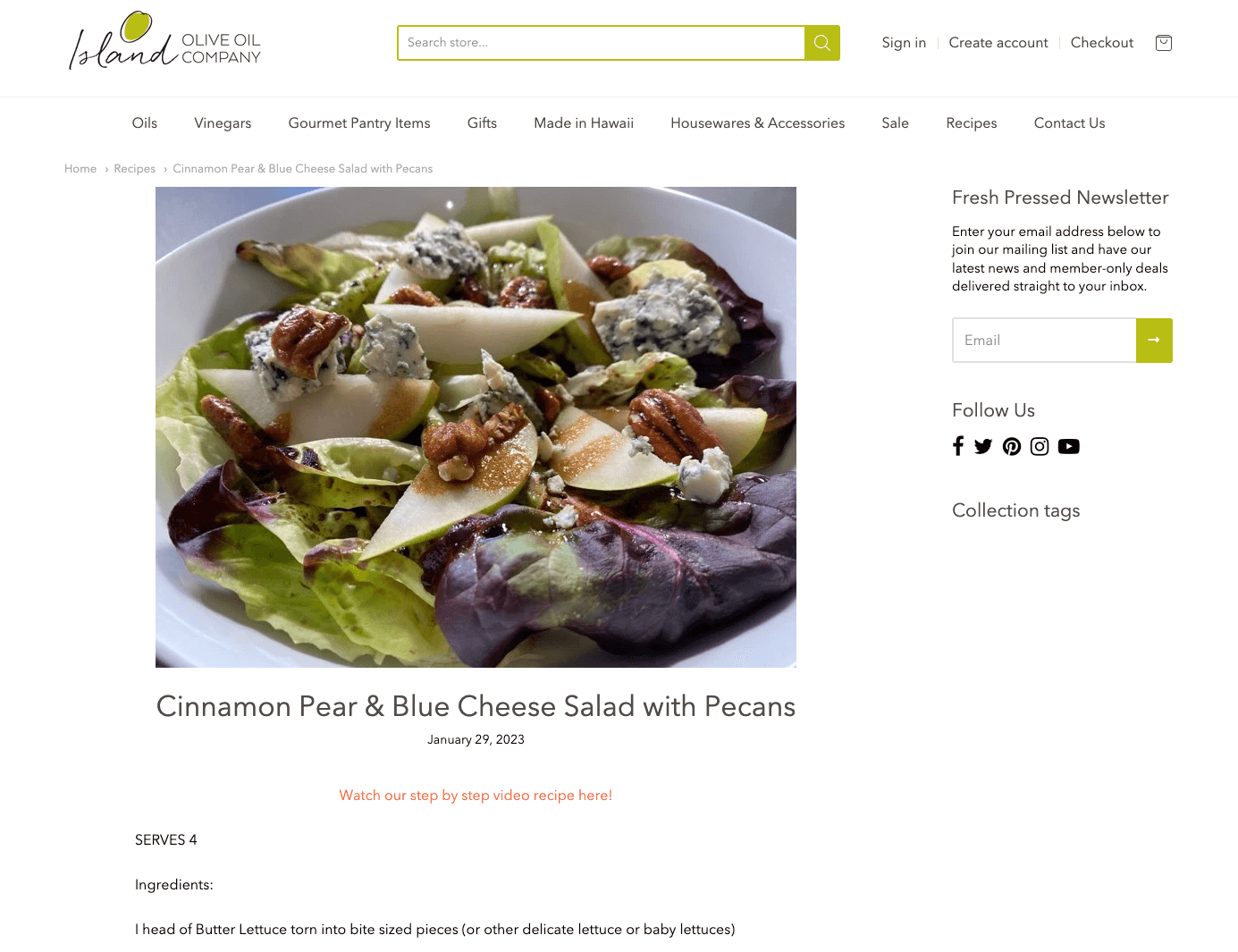
This article about a salad recipe is featured on the Island Olive Oil blog. As a gourmet store, Island Olive Oil produces content, such as recipes and promotions, to help drive traffic to its website.
In the Reach stage, customers are looking for products and services to address an issue or solve a problem. An informative, SEO-optimized blog with high-quality content can be a powerful tool to attract the right audience.
2. TOMS: website newsletter signup popup
Customer lifecycle stage: “Acquisition”
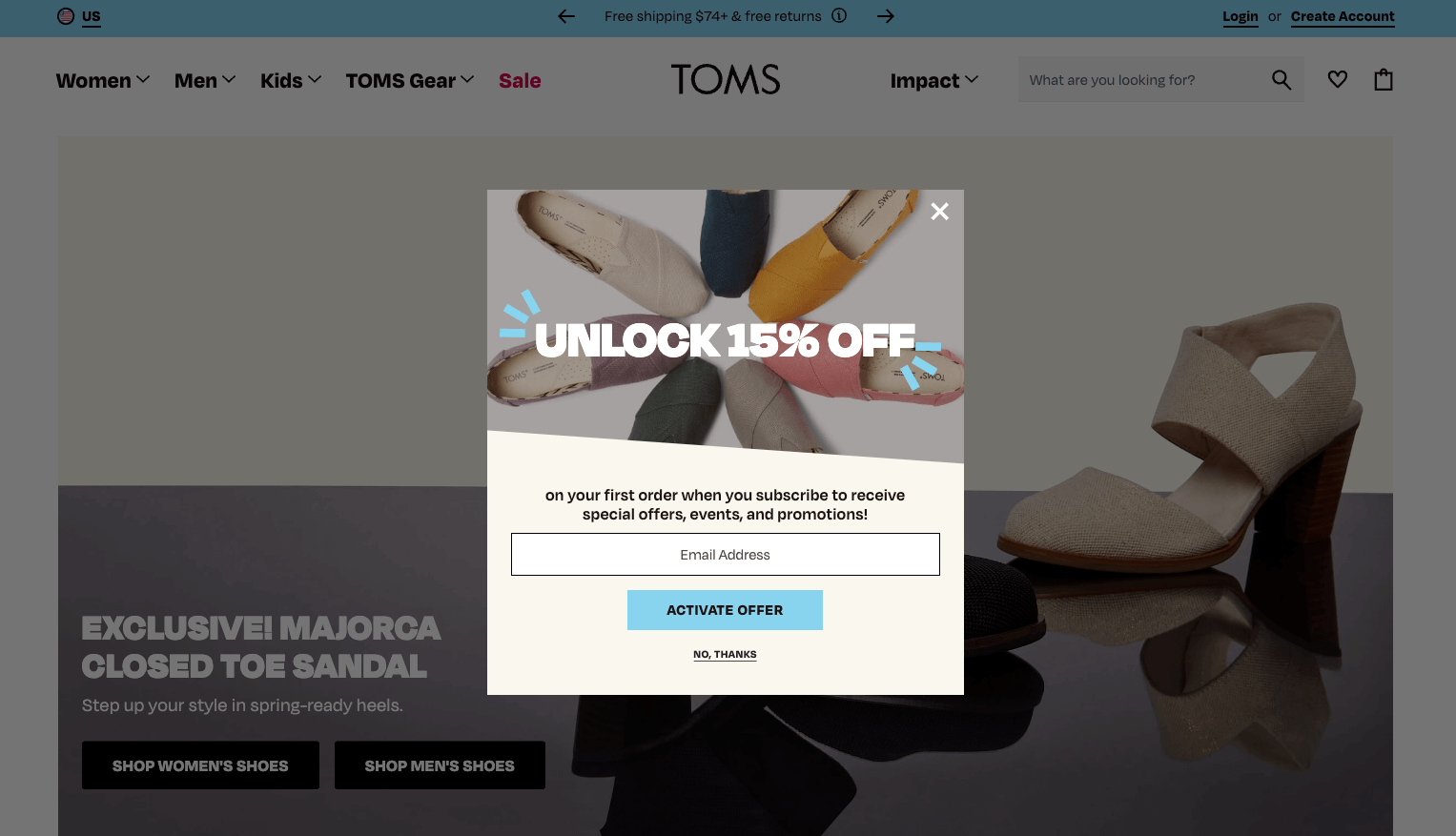
TOMS, the shoes and accessories brand, schedules popups on its website to capture the attention of visitors. In addition to promoting sales or special offers like the image above, there are many other ways to use popups to drive conversions.
At the Acquisition stage, customers are aware of your brand. Now is the time to pique their interest in your products or services.
So, the trick is to use popups to highlight discounts and offers, showcase customer reviews, and offer free trials or samples.
3. Island Olive Oil: welcome email
Customer lifecycle stage: “Conversion”

The image above is a welcome email that Island Olive Oil sends to its new subscribers. The catchy welcome email subject line, crisp content, and colorful layout place it among the best welcome emails we’ve seen.
Welcome emails are best used during the Conversion stage when a customer has already made a purchase. They help make a positive impression, introduce your brand, highlight your USP, and set the tone for future interactions.
With Omnisend, you can create and automate welcome emails to send to new subscribers or first-time customers. Leveraging the lifecycle stages and lifecycle map tool as Island Olive Oil does allows you to deliver the right message at the right time to the right customers.
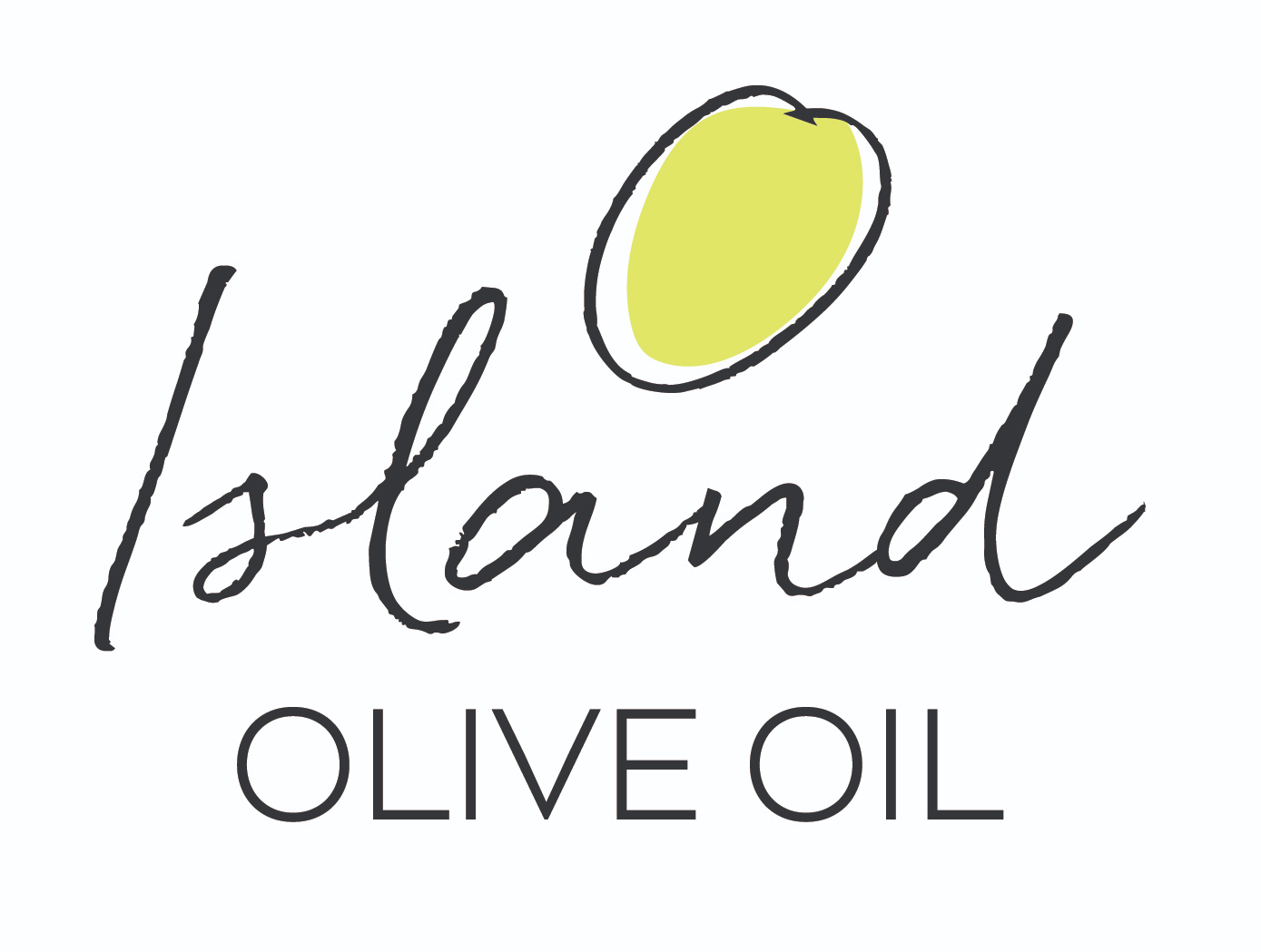 | “The lifecycle stage map is an incredible opportunity for a small business. This is the kind of thing that, otherwise, takes a marketing team to be able to do. It’s a simple way to see our customers’ shopping or purchasing habits in one place, and it’s really helped us to be able to target different groups. We’re competing with larger businesses, and this allows us to have that reach at the right time.” Angèl Foster, co-owner of Island Olive Oil Company Learn how Island Olive Oil uses Omnisend Lifecycle Stages |
4. Inglot Canada: sale promotion email
Customer lifecycle stage: “Retention”
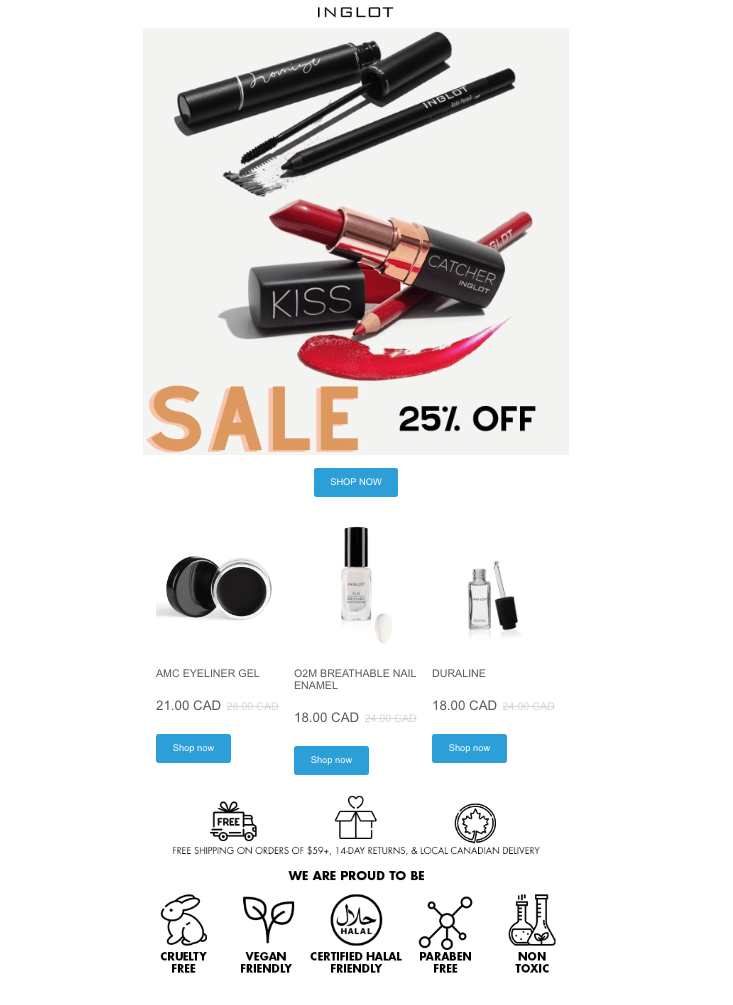
Another example of customer lifestyle marketing is the above sales promotional email from the popular beauty brand Inglot Canada. In this promotional email, Inglot offers a 25% discount, which can be a big incentive for customers to make another purchase.
One email marketing best practice is to use your promo emails during the Retention stage. Promotional emails are essential in email marketing, as they encourage customers to continue engaging with your brand and make more purchases.
5. Sephora: win-back email
Customer lifecycle stage: “Loyalty”
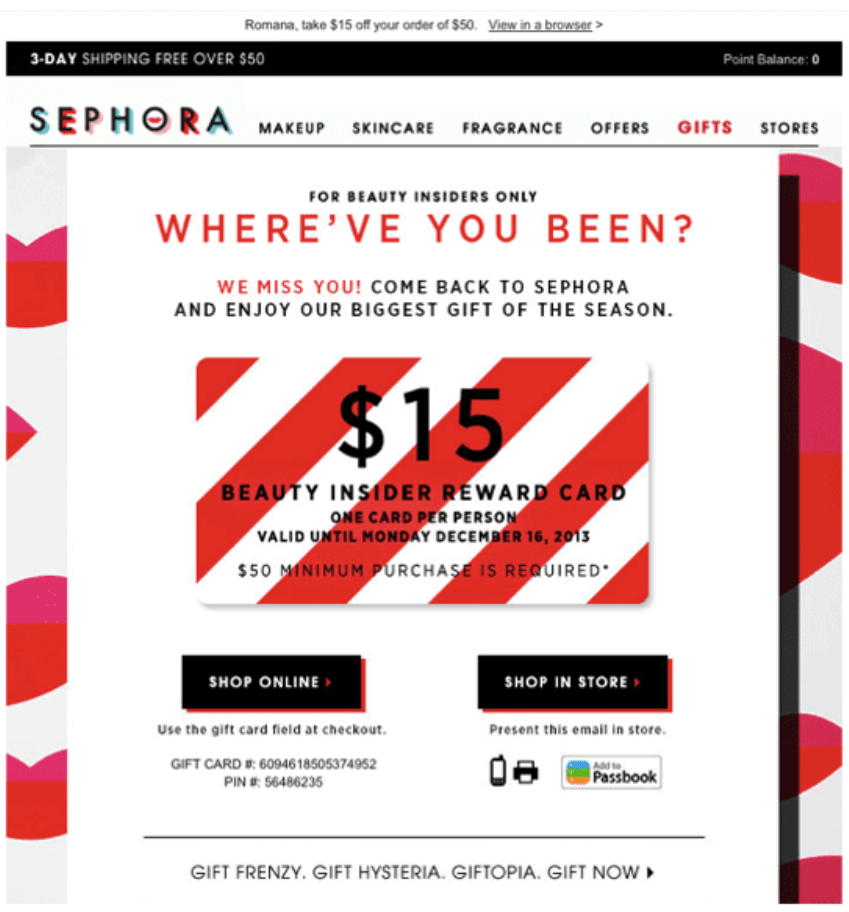
Sephora, the global beauty brand, sends out win-back emails like the one above to customers who have previously made a purchase but haven’t interacted with the brand in a while. As part of its customer reactivation marketing campaign, it encourages people to use the discount.
The goal at the Loyalty stage is to maintain customer loyalty and deepen the relationship with a customer. Post-purchase emails remind customers of the value your brand provides and encourage them to make another purchase.
6. Hairtamin: promotional push notification
Customer lifecycle stages: “Conversion” and “Retention”
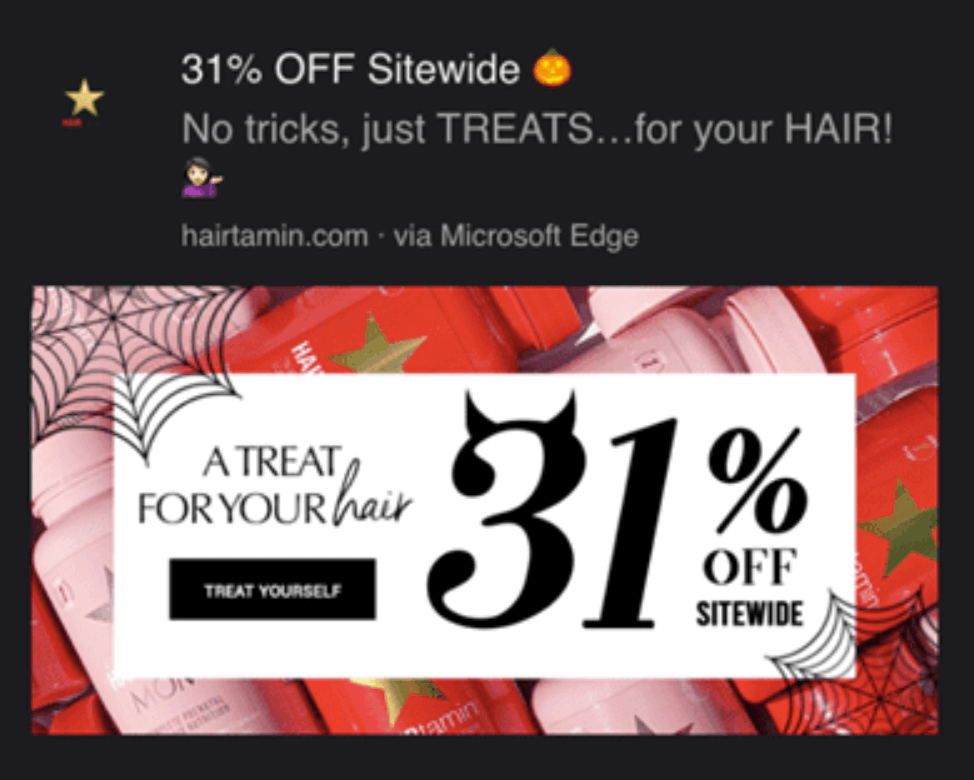
Promotional push notifications, such as those Hairtamin sends, can be effective at different stages of customer lifecycle marketing. The push notification above offers a sitewide discount to encourage new customers to buy and existing ones to make repeat purchases.
Web push notifications during the “Conversion” stage can be used to encourage customers to explore more products and make their first purchase. Different push notifications can be used in the “Retention” stage to encourage repeat purchases.
7. Amundsen Sports: product restock email
Customer lifecycle stages: “Retention” and “Loyalty”

Amundsen Sports sends product restocking announcement emails to customers who bought similar products. The brand has personalized the email above, which further encourages existing customers to make repeat purchases.
Product returns or back-in-stock marketing emails are best sent during the “Retention” stage to keep your customers engaged. They are also effective during the “Loyalty” stage of customer lifecycle marketing, helping you build strong customer relationships.
Customer lifecycle marketing strategies for every stage
Having an effective customer lifecycle marketing strategy can help you improve customer retention, increase customer lifetime value, and enhance customer experience. The following are effective lifecycle marketing ideas for each stage of the customer lifecycle:
1. Reach — build brand awareness
The primary goals of the Reach stage are to build brand awareness, reach new potential customers, and increase traffic to your website. So, the strategy you develop for this stage should be aimed at meeting these goals.
Customers in the Reach stage of customer lifecycle marketing are looking for information about a product or service. But they’re not yet aware that your business can help them achieve an objective.
Therefore, the marketing communication you design should highlight how your brand can help meet their needs. Here are some customer lifecycle marketing ideas to consider:
- Creating buyer personas: Buyer personas help you understand your target audience better and create relevant, personalized marketing messages that resonate with them
- Placing banner ads on websites: Targeted banner ads on relevant websites can help attract potential customers and drive traffic to your site
- Influencer marketing: Partnering with relevant influencers in your niche can help expand your brand’s reach and attract new customers. Learn the basics of influencer marketing here
- Content marketing: Creating valuable, informative content, such as blog posts, videos, and infographics, can attract potential customers and establish your brand as a thought leader in your industry
- Optimizing your website for SEO: Improving your website’s search engine rankings can increase organic traffic and attract more potential customers
Metrics to track:
- Website traffic
- Bounce rate
- Newsletter subscription rate
2. Acquisition — persuade potential customers
The Acquisition stage of customer lifecycle marketing aims to share information about your offers and persuade people to make their first purchase. It’s also about creating a positive first impression to attract potential customers to the brand.
At this stage, your customers are researching and evaluating different options to make an informed decision. They might compare prices, features, and benefits to see which product or service best fits their needs.
How To’ak Chocolate, for example, uses its welcome email series to establish trust and create a positive first impression. Sharing its brand story from different perspectives provides a personalized introduction and builds a connection with new subscribers.
Read the case study to learn more
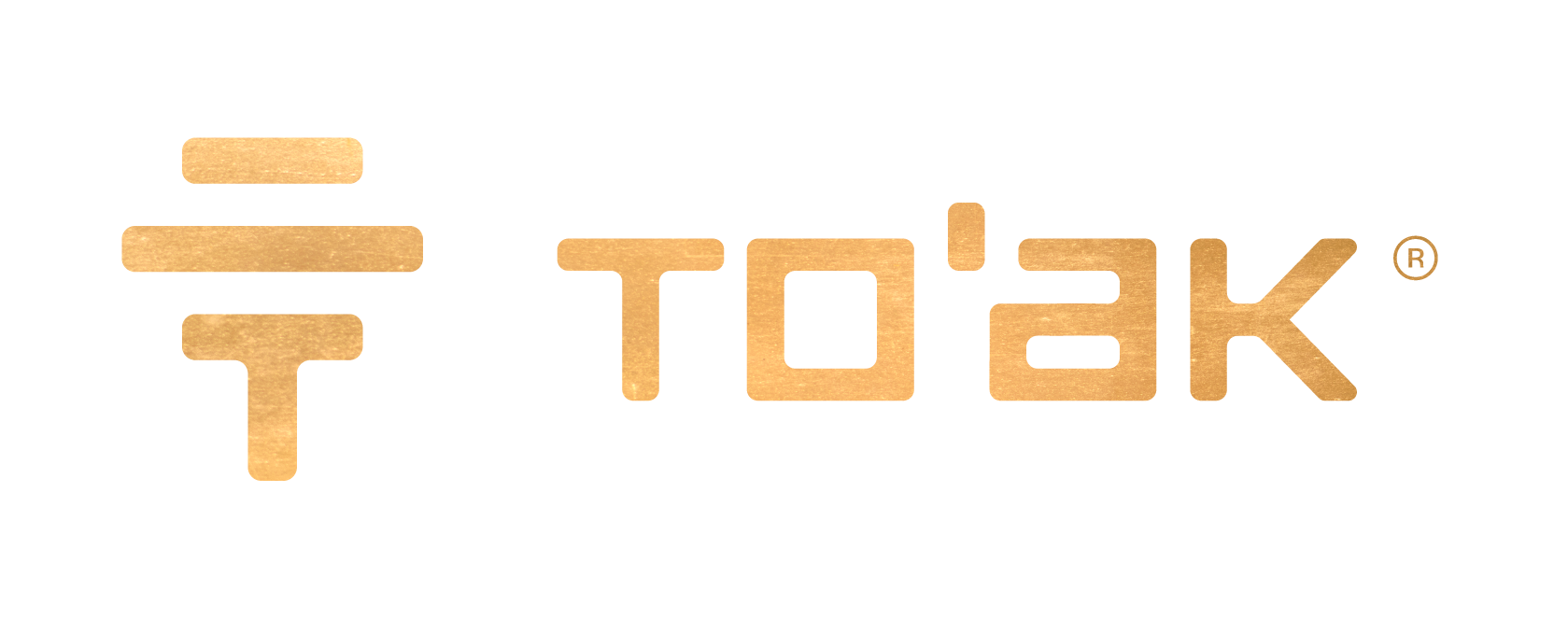 | “Our automated welcome series allows us to share our brand story with anyone who subscribes, which helps us communicate the uniqueness of our brand. We tell the story from the founder’s perspective, the farmer’s perspective, and from other voices. Today, customers get a personalized introduction to our brand. Email automation makes it possible for a small team like ours to show customers that we care about building a connection.” James Le Compte, co-owner of To’ak Chocolate |
Strategies to consider for the Acquisition stage of customer lifecycle marketing are:
- Creating product demos: Demonstrating how your product works and highlighting its key features can help potential customers understand its value and persuade them to make a purchase
- Writing informative blog posts: In-depth, educational blog content can position your brand as an expert in your industry and help potential customers make informed decisions
- Creating how-to guides, ebooks, and whitepapers: Comprehensive resources that provide actionable advice can attract leads and demonstrate your brand’s expertise
- Providing social proof through case studies: Showcasing real-world examples of how your product or service has helped other businesses can build trust and credibility with potential customers
- Designing easy-to-navigate landing pages: Optimizing your landing pages for conversions with clear calls-to-action and streamlined design can improve lead generation
Metrics to track:
- Website engagement
- Lead conversion rate
- Lead quality
3. Conversion — encourage the first purchase
The Conversion stage is where a potential customer decides whether or not to make a purchase. At this stage, many customers have already shortlisted brands they like.
But they may still be looking for a discount or a better deal. The primary goal is to encourage the customer to take that final step.
Baking Steel uses different emails (promotional, automated, abandoned carts, and more) to convert its customers. By leveraging email marketing, the brand has increased email-attributed revenue by 30% and growth in overall revenue by 15%.
Read the case study for more details
Consider the following strategies at the Conversion stage of customer lifecycle marketing:
- Highlighting unique features and benefits: Communicate how your product solves customer pain points and offers unique value to differentiate your brand from competitors
- Responding to queries and complaints: Prompt, helpful customer service builds better trust and shows that you value your customers’ needs and concerns
- Offering incentives: Incentives like first-time purchase discounts, limited-time promotions, or rewards for repeat purchases motivate customers to take action
- Offering free trials: A free trial period for subscription-based products or services allows potential customers to experience the value firsthand before purchasing
- Sharing testimonials: Positive reviews and testimonials from satisfied customers can provide social proof and build confidence in your brand
Metrics to track:
- Sales conversion rate
- Website traffic
- Net promoter score — learn how to measure customer satisfaction
4. Retention — keep customers engaged
The Retention stage of customer lifecycle marketing is about building long-term customer relationships and brand loyalty. Your goals here are to increase revenue, reduce customer churn, and create a sustainable business model.
Customers at this stage want to feel satisfied with their experience with the brand. They expect consistent quality, reliability, and value from the products or services they purchase.
They may also expect excellent customer service, personalized attention, and proactive communication. Here are some strategies to consider for customer retention:
- Providing multiple support options: Offer various channels for customer support (email, phone, live chat, social media) to ensure that customers can easily reach out and get help when needed
- Streamlining the onboarding process: Help customers quickly understand and start using your product or service to reduce churn
- Sending personalized follow-up emails: Check-in with customers after their purchase, provide helpful resources, and gather feedback to show you value customer experience and satisfaction
- Providing personalized product recommendations: Use customer data and purchase history to suggest relevant products, encourage repeat purchases, and boost customer lifetime value. Learn how to set up product recommendations
- Offering a discount code for future purchases: Incentivize customers to make another purchase with a personalized discount code to encourage greater loyalty and repeat business
Metrics to track:
- Customer retention rate
- Churn rate
- Customer satisfaction score
5. Loyalty — turn customers into brand advocates
At the Loyalty stage of customer lifecycle marketing, your goals are to retain customers, enhance customer satisfaction, and build strong, long-term customer relationships. Customers at this stage usually make repeat purchases and view your brand positively.
Your approach should be to provide high-quality products or services and to make your customers feel appreciated and valued. Here are some strategies to consider:
- Offering exclusive rewards: Provide special perks, early access to sales, or exclusive products to your most loyal customers to make them feel valued and appreciated
- Setting up a referral program: Encourage satisfied customers to refer their friends and family to attract new customers and foster a sense of community among loyal customers
- Requesting feedback: Send product review request emails to get input from loyal customers This shows that you value their opinions and want to continuously improve their experience
- Offering free products or discounts: Reward customers who take the time to provide a testimonial or review with a small gift or discount code to encourage them to continue advocating for your brand
Metrics to track:
- Customer retention rate
- Net promoter score
- CLV
Customer lifecycle marketing: summary
Customer lifecycle marketing is a strategy that targets customers at various stages of their buying journeys. It focuses on the entire customer journey, from acquiring new customers to retaining existing ones.
With the right approaches, you can align customer lifecycle marketing with your current practices. The results? Improved customer engagement, increased customer satisfaction, and higher revenue.
Are you looking for a better way to enhance your marketing strategies? Get started with customer lifecycle marketing to build long-term customer relationships, increase brand loyalty, and boost your brand’s CLV.
quick links
related features
No fluff, no spam, no corporate filler. Just a friendly letter, twice a month.
